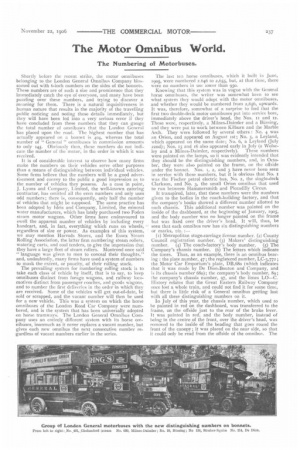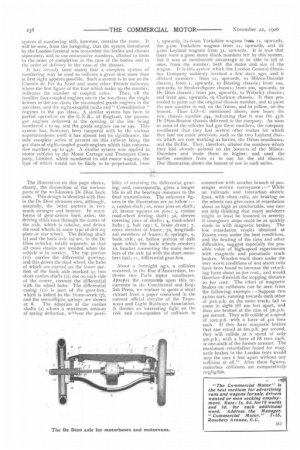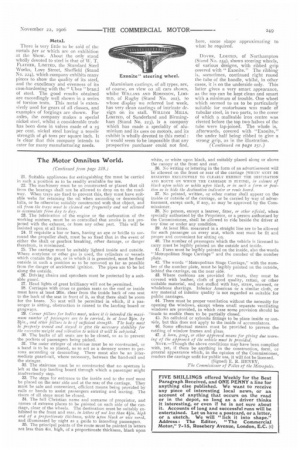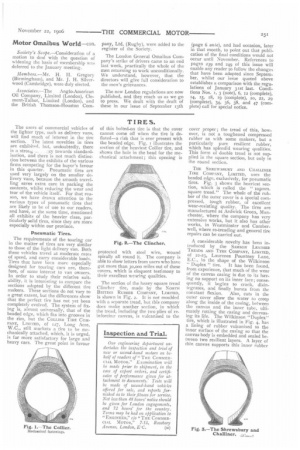The Motor Omnibus World.
Page 7

Page 8

Page 23

Page 24

Page 25

If you've noticed an error in this article please click here to report it so we can fix it.
The Numbering of Motorbuses.
Shortly before the recent strike, the motor omnibuses belonging to the London General Omnibus Company blossomed out with 6-inch numbers on the sides of the bonnets. These numbers are of such a size and prominence that they immediately catch the eye of everyone, and many have been puzzling over these numbers, and trying to discover a meaning for them. There is a natural inquisitiveness in human nature that results in the majority of the travelling public noticing and noting these details immediately, but they will have been led into a very serious error if they have concluded from these numbers that they can gauge the total number of omnibuses that the London General has placed upon the road. The highest number that has actually appeared on a bonnet is 404, whereas the total number of " General " omnibuses in commission amounts to only 145Obviously then, these numbers do not indicate the number of the motor, in the order in which it was received.
It is of considerable interest to observe how many firms make the numbers on their vehicles serve other purposes than a means of distinguishing between individual vehicles. Some firms believe that the numbers will be a good advertisement and convey to the public a good impression as to the number of vehicles they possess. As a case in point, J. Lyons and Company, Limited, the well-known catering contractor, has omitted all the even numbers and only uses odd numbers; there is, consequently, only half the number of vehicles that might be supposed. The same practice has been adopted by Idris and Company, Limited, the mineral water manufacturers, which has lately purchased two Foden steam motor wagons. Other firms have endeavoured to swell the apparent number of vehicles by including every handcart, and, in fact, everything which runs on wheels, regardless of size or power. As examples of this system, we may mention Harrods Stores, and the Essex Steam Rolling Association, the latter firm numbering steam rollers, watering carts, and coal tenders, to give the impression that they have a large fleet of steam rollers. Montrond once said " language was given to men to conceal their thoughts," and, undoubtedly, many firms have used a system of numbers to mask the extent, or paucity, of their roiling stock. The prevailing system for numbering rolling stock is to take each class of vehicle by itself, that is to say, to keep omnibuses distinct from forage wagons, and railway locomotives distinct from passenger roaches, and goods wagons, and to number the first deliveries in the order in which they are received. Some of the vehicles will get out-of-date, be sold or scrapped, and the vacant number will then be used for a new vehicle. This was a system on which the horse omnibuses of the London Road Car Company were numbered, and is the system that has been universally adopted on horse tramways. The London General Omnibus Company uses an entirely different system with its horse omnibuses, inasmuch as it never replaces a vacant number, but gives each new omnibus the next consecutive number regardless of vacant numbers earlier in the series. last ten horse omnibuses, which it built in June, 1905, were numbered 2.646 to 2,655, but, at that time, there were no numbers in use lower than 95o.
Knowing that this system was in vogue with the General horse omnibuses, the writer was somewhat keen to see what system they would adopt with the motor omnibuses, and whether they would be numbered from 2,656, upwards. It was, therefore, somewhat of a surprise to find that the first two double-deck motor omnibuses put into service bore, immediately above the driver's head, the Nos. II and 12. These were, respectively, a Milnes-Daimler and a Bussing, and they were put to work between Kilburn and the Marble Arch. They were followed by several others : No. 4 was an Orion, and appeared on August 1st; No. 5, a Leyland, which appeared on the same date; No. 6, a Leyland (July 22nd); Nos. 15 and 16 also appeared early in July (a Wolseley and a Milnes-Daimler, respectively). These numbers were painted on the lamps, so it was evidently intended that they should be the distinguishing numbers, and, in October, they were also painted on the frame, on the offside under the bonnet. Nos. I, 2, and 3 have never been seen in service with these numbers, but it is obvious that No. x was the Fischer petrol electric bus, No. 2, the single-deck Clarkson, and No. 3, the small Orion omnibus that used to run between. Hammersmith and Piccadilly Circus. It transpired, later, that these numbers were the numbers given to the bodies in the coach-building factory, and that the company's books showed a different number allotted to each chassis. This additional number was painted on the inside of the dashboard, at the beginning of January, 1905, and the body number was no longer painted on the frame but was fixed over the driver's head. It will, thus, be seen that each omnibus now has six distinguishing numbers or marks, 7.4z. :—
(/) Metropolitan stage-carriage license number. (2) County Council registration number. (3) Makers' distinguishing number. (4) The coach-factory's body number. (5) The Company's chassis number. (6) The letters which indicate the times. Thus, as an example, there is an omnibus bearing: the plate number, 47; the registered number, LC-3,772 ; the Motor Car Emporium's plate, DB,68o (which indicates that it was made by De Dion-Bouton and Company, and is its chassis number 68o); the company's body number, 89; the company's chassis number, 97, and the times LO—C. History relates that the Great Eastern Railway Company once lost a whole train, and could not find it for some time, but there is little risk of a General omnibus getting lost with all these distinguishing numbers on it.
In July of this year, the chassis number, which used to be painted in red on the dashboard, was transferred to the frame, on the offside just to the rear of the brake lever. It was painted in red, and the body number, instead of being in the centre of the front, over the driver's head, was removed to the inside of the beading that goes round the front of the canopy; it was placed on the near side, so that it could only be read from the offside of the omnibuq. The
system of numberingstill, however, remains the same. It will be seen, from the foregoing, that the system introduced by the London General was to number the bodies and chassis separately, and to use consecutive numbers, allotted to them in the order of completion in the case of the bodies and in the order of delivery in the case of the chassis.
It has already been stated that a complete system of numbering may be used to indicate a great deal more than at first sight appears passible_ Such a system is in use on the Chemin de Fer du Nord and some other French railways, where the first figure of the four which make up the number,
indicates the number of coupled axles. Thus, all the familiar four-coupled engines are in the 200 class, the single drivers in the too class, the six-coupled goods engines in the 3430 class, and the eight-coupled tanks and " Consolidation " engines in the 400 class. A similar system has been in partial operation on the G.N.R., of England, the passenger engines delivered at the opening of the line being numbered i to 99, and the goods engines WO to 199. This system has, however, been tampered with by the various superintendents until it has almost lost its significance, the only complete series at present on this railway being the 401 class of eight-coupled goods engines which take consecutive numbers up to 436. A similar system was applied to motor vehicles by the Motor Cartage and Transport Company, Limited, which numbered it odd motor wagons, the type of which would not be likely to be perpetuated, from t, upwards, its 6-ton Yorkshire wagons from it, upwards, the 5-ton Yorkshire wagons front 21, upwards, and its 5-ton Leyland wagons from 31, upwards. It is true that there were a good many blank numbers kfi by this system, but it was of inestimable advantage to be able to tell at once, from the number, both the make and size of the wagon. it is this system which the London General. Omnibus Company suddenly invoked a few days ago, and it allotted numbers ; from at, upwards, to Milnes-Daimler chassis; from i, upwards, to Bussing chassis; from too, upwards, to Straker-Squire chassis; from 200, upwards, to De Dion chassis; from 300, upwards, to Wolscley chassis; and from 400, upwards, to Clarkson chassis. It then proceeded to paint out the original chassis number, and to paint the new number in red, on the frame, and in yellow, on the bonnet, Thus 1.0—C mentioned above, now bears the new chassis number 244, indicating that it was the 45th De Dion-Bouton chassis delivered to the company. As soon as most of the vehicles had got these numbers, the company recollected that they had several other makes for which they had not made provision, such as the two Le.yland chassis which are now working as lorries, the Orion omnibuses, and the Brillie, They, therefore, altered the numbers which they had already painted on the bonnets of the MilnesDaimlers and made them 20 higher, and used the earlier numbers from ot to 020 for the old chassis. Our illustration shows the bonnet of one in each series.
21. Suitable appliances for extinguishing fire must be carried in such a position as to be readily available for use. 22. The machinery must be so constructed or placed that oil from the bearings shall not be allowed to drop on to the roadway. When trays are fixed to prevent this, they must have suitable webs for retaining the oil when ascending or descending hills, or be otherwise suitably constructed with that object, and oil from the trays must be cleaned out frequently and not allowed to accumulate from day to day. 23. The lubrication of the engine or the carburation of the working mixture, must be so controlled that smoke is not projected with the exhaust, or from any other part. This will be insisted upon at all times.
24. If requisite a bar or bars, having an eye or bridle to surround the propeller shaft, must be so fixed that in the event of either the shaft or gearbox breaking, other damage, or danger therefrom, is minimised.
25. The carriage most be suitably lighted inside and outside. Where acetylene or other gas is used, the cylinders or vessels which contain the gas, or in which it is generated, must be fixed outside in such a position as to be removed as tar as possible from the danger of accidental ignition. The pipes are to be led along the outside.
26. Driving chains and sprockets must be protected by a suitable guard.
27. head lights of great brilliancy will not be permitted.
28. Carriages with cross or garden seats on the roof or inside must have at least 26in. clear from the inside back of one seat to the back of the seat in front of it, so that there shall be room for the knees. No scat will be permitted in which, if a passenger is sitting, obstruction is caused to the landing board or gangways.
29. Corner pillars for bodies must, where it is intended the maximum number of passengers are to be carried, be at least 3iin. by 31in., and other pillars to be of sufficient strength. The body must be properly ironed and stayed to give the necessary stability for the excessive weight and vibration to which it will be subjected. 30. The backs of all seats are to be closed, so as to prevent the pockets of passengers being picked. 31. The outer stringer of staircase must be so constructed, or a band is to be so placed, as to act as a decency screen to persons ascending or descending. There must also be an intermediate guard-rail, where necessary, between the hand-rail and the stringer.
32. The staircase must be so constructed that no aperture is left at the top landing board through which a passenger might inadvertently step. 33. The steps for entrance to the inside and to the roof must be placed on the near side and at the rear of the carriage. They must be safe and convenient, efficient means being provided by rails or bands to assist passengers entering and leaving. The risers of all steps must be closed.
34. The full Christian name and surname of proprietor, and names of extreme places to be painted on each side of the car
riage, clear of the wheels. The destination must be suitably exhibited to the front and rear, in letters of not less than 4fin. high and of a proportionate thickness, white upon black or vice versd, and illuminated by night as a guide to intending passengers.
35. The principal points of the route must be painted in letters not less than 4in. high, of a proportionate thickness, black upon white, or white upon black, and suitably placed along or above the canopy at the front and rear.
36. No writing or lettering in the form of an advertisement will he allowed on the front or rear of the carriage (svotou MUST BE RESERVED EXCLUSIVELY TO CLEARLY EXHIBIT THE DESTINATION AND ROUTE ON WHTCH THE CARRIAGE IS PINING), in colours of black upon while or white upon black, or in such a form or posilion as to hide the destination indicator or route board.
37. No printed, written, or other matter shall appear on the inside or outside of the carriage, or be carried by way of advertisement, except such, if any, as may be approved by the Commissioner.
38. No person, except a learner, fitter, or other offlcial, when specially authorised by the Proprietor, or a person authorised by the Commissioner, shall be allowed to ride beside the driver at any time or under any condition_ 39. At least 16in. measured in a straight line are to be allowed for each passenger on every seat, which seat must be fit and proper and convenient for sitting on.
441. The number of passengers which the vehicle is licensed to carry must be legibly painted on the outside and inside.
41. Fares must be legibly painted on the inside, also the words " Metropolitan Stage Carriage" and the number of the number plate.
42. The words "Metropolitan Stage Carriage," with the number of the number plate, must be legibly painted on the outside, behind the carriage, on the near side.
48. Where cushions are provided for seats, they must be covered with leather, cloth of good quality, rattan, or other suitable material, and not stuffed with hay, straw, seaweed, or whalebone shavings. Inferior American or a similar cloth, or any material of inferior quality is not regarded as suitable for public carriages.
44. There must be proper ventilation without the necessity for opening the windows, except where small separate ventilating windows are provided, in which case some provision should be made to enable them to be partially closed.
4.5. No celluloid or xylonite fittings to be place inside or outs side, but this does not apply to the inside of accumulators. 46. Some effectual means must be provided to prevent the rattling of window frames and glass. 47. A horn, gong, or other approved means for giving due warns ing of the approach of the vehicle must be provided.
NOTE.-Though the above conditions may have been complied with, yet, if there be anything in the construction, form, or general appearance which, in the opinion of the Commissioner,. renders the carriage unfit for public use, it will not be licensed.
(Signed) E. R. HENRY,
The Commissioner of Police of the Metropolis. Mr. Thomas Clarkson has been elected a member of the Chelmsford Town Council, where he headed the poll in the South Ward on the 9th instant.
Lord Montagu of Beaulieu, on Friday last, introduced a deputation to the Home Secretary. Mr. Arthur Stanley, M.P., Mr. Sidney Straker, Mr. D. Duff (the Road Car Company), and Mr. R. S. Tillingrepresented the several interests concerned, and Mr. Gladstone assured them their views would receive full consideration.
The Brighton, Hove and Preston United Omnibus Company, Limited, has decided not to appeal against a fine
of Is., recently imposed upon one A.)f its drivers for allowing smoke to escape with the exhaust from an omnibus engine. There was, probably, some clear omission on the part of one of the company's men in this particular case.
The report, published in " The Daily Mail " of the 17th instant, that the London Road Car Company's "Union Jack " omnibuses had been removed from the Cheapside, Holborn and Oxford Street route, owing to "skidding," is not, we are assured by Mr George de Prelle, the engineer-in-chief of that company, accurate. The service in question has now been diverted at Oxford Circus, the motorbuses running down Regent Street to Charing Cross, because this line suits the company's arrangements better.
A movement in support of motor omnibuses, at Alfreton, Derbyshire, is in the hands of Mr. H. R. Cleave, solicitor, High Street. Mr. J. Spencer, the Honorary Secretary to the Alfreton Town and Trade Association, is also taking an active interest in the matter.
Several heavy claims for damages have lately been decided against motorbus companies, in respect of accidents due to side-slip. If this kind of thing continues much longer, it is evident that the expeases in settlement of claims will become unduly high, and that the companies will have to cover themselves by raising fares
Anent the controversy upon the subject of motorbus services in the Richmond district, it is interesting to note that, whilst residents near Barnes and Mortlake signed a petition against the services, the last meeting of the Richmond Ratepayers' Association was conspicuous for the vigour of the support given, to the improved travelling facilities provided by the motors in question.
The Torquay and District Motor Omnibus Company, Limited, has issued its report for the year ending September zoth last. This shows a balance of .;61,702 7s. rod. on revenue account, from which depreciation charges amounting to L:636 6s. rid, have to be deducted. The directors recommend that ,*()no be placed to reserve fund, making this stand at 4'1,300, the payment of a dividend at the rate of 71 per cent. per annum, free of income tax,
and the carrying forward of the bal ance. The whole of the company's plant consists of Chelmsford steam omnibuses, constructed by Clarkson, Limited, of Chelmsford, and these machines, eight in number, have, certainly, proved most successful. The capital of the company is only ..5.,000, divided into Li shares, and we must congratulate the management upon the continued prosperity of the undertaking.
Omnibus Engineers.
A special meeting of Council was held, at 1, Albemarle Street, W., on Monday, November 12th, at 7 o'clock, when Mr. F. C. A. Coventry (Great Western Railway), Chairman, presided. There were also present :. Mr. E. Shrapnell Smith, Vice-President (by invitation); Mr. W. Flexmart French, Mr. George Pollard, and Mr. Percy Frost Smith. In attendance, the Secretary.
The Chairman exitia:aea that this extra meeting had been called to consider Lord Montagu's offer to introduce a deputation from the Society to the Home Secretary, if it were thought expedient to follow that course. After full discussion, a number of points, connected with the daily working of motorbuses in London, were set down for circulation to the members of Council. It was agreed that Lord Montagu should be asked, subject to the confirmation of the full Council on the 29th instant, to introduce a small deputation to the Chief Commissioner of Police for the Metropolis, instead of to the Home Secretary. Society's Scope.—Consideration of a motion to deal with the question of widening the basis of membership was deferred to the January meeting.
Members.—Mr. H. II. Gregory (Birmingham), and Mr. J. H. Silverwood (Cambridge), were duly elected.
Associates.—The Anglo-American Oil Company, Limited (London), Clement-Talbot, Limited (London), and the British Thomson-Houston Corn
pany, Ltd. (Rugby), were added to the register of the Society.
The London General Omnibus Company's strike of drivers came to an end last week, practically the whole of the men returning to work unconditionally. We understand, however, that the directors will give full consideration to the men's grievances.
The new London regulations are now published, and they reach us as we go to press. We dealt with the draft of these in our issue of September i3th
(page 6 ante), and had occasion, later in that month, to point out that publication of the final conditions would not occur until November. References to pages 239 and 249 of this issue will enable any reader to follow the changes that have been adopted since September, whilst our issue quoted above establishes a comparison with the regulations of January 31st last. Conditions Nos. t, 3 (note), 6, 12, (complete), 14, IS, 18, 19 (complete), 20, 22, 29 (complete), 34, 36, 38, and 47 (complete) call for special notice.


































